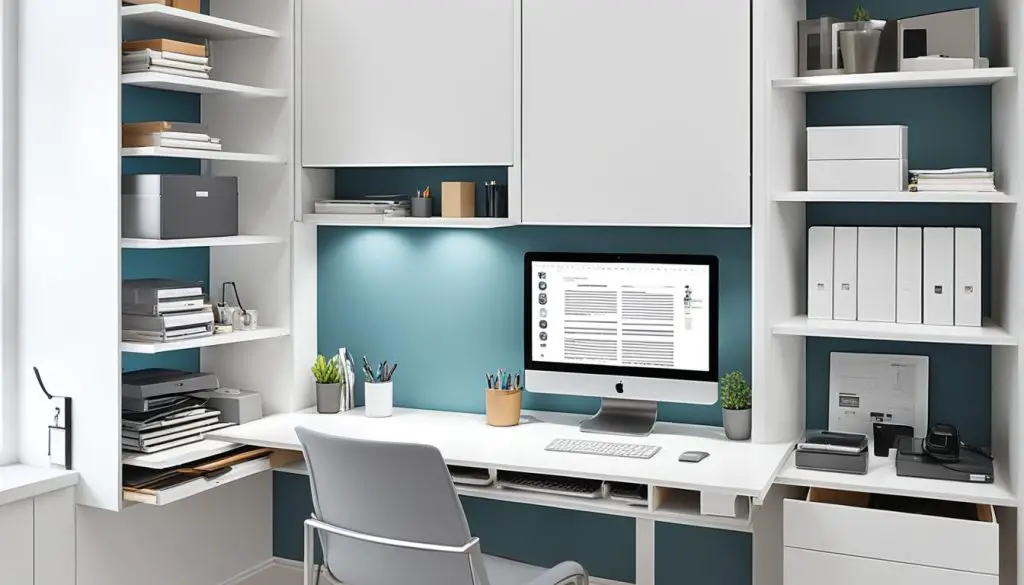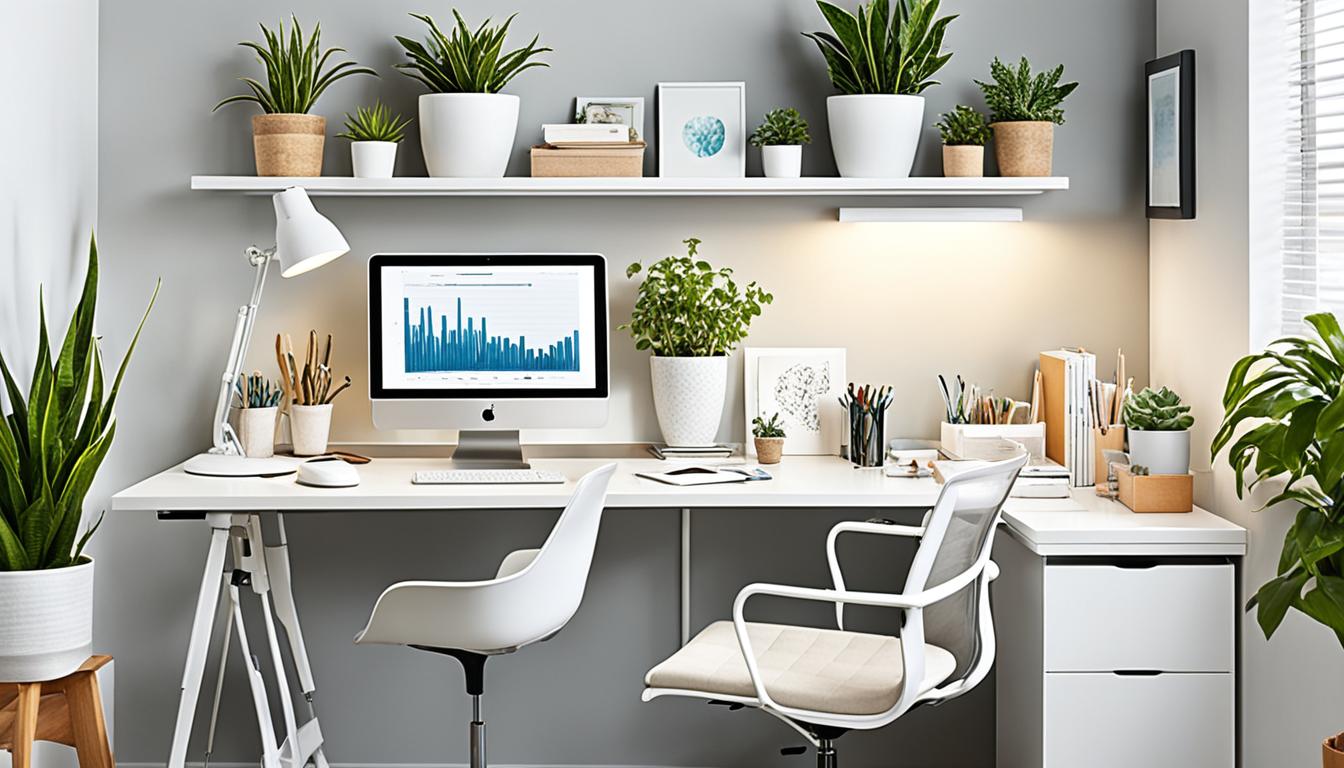Seeing my wife fight endometriosis and fibromyalgia showed me how important a cozy home office is for chronic pain. In our time, having a good workspace at home matters more than before. Building a home office that’s both cozy and good for your pain is our goal today. We will look into smart ways to save space and make your office healthier.
Today, everyone knows having a proper home office is key. Many of us sit a lot at work1, which can cause pain and bad posture. The right setup can either make you love or hate working from home. So, I’ve gathered 30 cool space-saving tips to set up or spruce up your home office.
Picking a look for your office comes first. Then, add space-saving furniture, like folding desks, and clever storage. You can even put up plants or art that help you feel better. These ideas will help you make an office that’s good for work and your health. Let’s get your perfect home office started.
The Importance of an Ergonomic Home Office
Many people face challenges at work because of chronic pain. Bad workspace designs and sitting too long can make pain worse.2 This pain can lead to missed work and lower productivity. But, workspaces can be adjusted to help.
Having a workspace that’s ergonomic is good for everyone. It’s even more crucial for those dealing with chronic pain. Placing chairs and computer equipment correctly can cut down on pain.2 An office chair should fit the shape of your back well. It should allow your thighs to be level with the floor. The screen should stand directly in front of you. This helps prevent neck pain, with the top of the screen at eye level or slightly lower.2
Reducing Workspace-Related Pain
Dealing with pain at work leads to less work done and more stress. But, working environments can adapt to help. This is especially crucial for those with chronic pain.
Correct Placement of Office Equipment
Setting up chairs and computers right can prevent pain at work.2 A good office chair supports your back and aligns your thighs properly. The screen should be right in front of you. Its top must be at eye level or slightly lower. This keeps your neck and shoulders from hurting.2
Adjustable Workstation: Standing and Sitting Desks
A desk that lets you stand or sit is great for your health and work. It helps to adjust your position during the day, which is better for your body. Sitting all day is harmful, both for your health and how clear you think. Autonomous offers many Standing Desks, perfect for any office style.
Benefits of a Sit-Stand Desk
Having a sit-stand desk at home comes with many perks. It can lower the health risks of sitting too long, such as back pain and poor blood flow. This can make you more productive and feel better overall.3 Plus, it encourages you to move and keeps your body in a better position.
Autonomous Standing Desk Options
Autonomous has a big selection of standing desks to meet different needs and liking. They offer desks that change height and converters for existing desks. One unique item is the LeanRite standing desk chair, designed for people of various heights and with a high weight limit.3 Whether it’s outfitting your current office or setting up a new one, Autonomous has everything you need for a comfortable, personalized workspace.
Space-Saving Home Office Chronic Pain
The goal of space-saving office design is better function and a good-looking office. It aims to boost productivity, using the space wisely. It must also consider ergonomics.1 When setting up your office, think about each worker’s area and needs. This way, you help them work better and feel good while doing so.
1 Many people sit a lot at work, which can lead to chronic neck or back pain. They may sit with bad posture or feel tight. The right desk setup and exercises can reduce this pain. It also helps with strength and flexibility.1 Teaching people to sit well can really help their body. For example, sitting with their elbows at a 90-degree angle can keep their arms from getting sore.
1 It’s key to move often if you sit a lot at work. This helps prevent pain. Suggesting simple daily stretches and recommending helpful products like the TheraBand exercise ball can make a big difference. They can lessen pain and boost recovery efforts.1
4 A study by Nulab found that 72% of remote workers didn’t have a proper home office space.4 Also, 40% didn’t use a desk for their work from home. To ease back and neck strain during long video calls, suggesting a slight recline can be helpful.4 Adding back support with a pillow or towel can lower back stress.4 For more comfortable sitting, advising to elevate the feet when the chair is too tall can help. Also, moving and stretching every hour or so can reduce back strain when working at home.4
Compact and Multifunctional Furniture
Who said home computer desks need to have legs? In houses short on space, a floating home office workstation is perfect.5 These desks save space and look great. They are also easy to match with your home’s décor. For those who like to be mobile or need a lot of space, corner desks are fantastic.6 L-shaped desks work well if you have two monitors or many items on your desk.
Floating Desks
5 Small spaces benefit a lot from multifunctional furniture. This trend helps make the most of every inch.5 It’s a solution for small homes or apartments, cutting down on clutter. Some innovative designs even include furniture that changes, like beds that turn into desks.
Corner Desks
6 Furniture that does more than one thing is a life-saver in tiny offices. These desks cater to many needs, from writing to computer work.6 Tables can act as meeting spots too. Some versions fold to take up less space, making them perfect for tight areas.
Multi-Level Desks
Desks with shelves above help keep papers and items neat and organized.5 Many furniture makers are creating pieces that have more than one use. This includes sofas that turn into beds or stools that have hidden storage.
Built-In Nook Desks
Built-in nooks are great for those who want a desk that saves space. You can add storage during its creation, making it very efficient.5 Qbit, a company from Taiwan, makes furniture that can change with you. Imagine furniture as versatile as LEGO bricks for adults.
5 They have unique items like beds that have extra features. These include massage chairs and USB ports. It shows how flexible furniture can be for different lifestyles.

Ergonomic Seating for Chronic Pain Relief
Your desk chair is key for both comfort and health at home. Ergonomic chairs are designed to make you feel good and support your back. They can be changed to fit you just right, making sure your posture is strong. The Autonomous Chair Ergo is a top pick for these reasons.7
Ergonomic Office Chairs
These chairs are all about keeping your back happy and helping you sit up straight. They come with special settings to fit your body, such as lower back support and how high the seat is. It’s important to have one if you deal with long-term pain and work at a desk3.
Autonomous Chair Ergo
The Autonomous Chair Ergo stands out with its comfort and style. You can change the back, seat, and armrests to feel just right. This keeps your body in a good position and eases the pressure on your spine. Plus, the material lets air pass through, keeping you cool all day8.
Ergonomic Stools
If sitting all day isn’t for you, check out the Autonomous Chair Move. It’s great for those with standing desks but wanting to sit sometimes. These stools are also good for your back and let you move around more while you work. This helps you avoid the problems of sitting too much3.
Organized and Clutter-Free Workspace
Keeping your workspace clean is vital for working better, feeling less stressed, and making a peaceful place to be creative. Use tools like drawer dividers, filing cabinets, and wall racks to improve your space. Let’s look at some simple ways to beat the mess and make your work area work for you.9
Drawer Dividers
Drawer dividers help you keep your stuff neat and easy to find. Just put them in your drawers to sort your things. Now, everything will have its own spot.9
Swivel Desk Drawers
The Autonomous swivel desk drawer is convenient and doesn’t take up any extra room. It helps you keep your desktop clear so you can work better.9
Filing Cabinets
A filing cabinet is essential for storing papers and documents. It helps you keep your work area tidy and your important files in one place.9
Wall Racks
Add wire wall racks to store papers or notes off your desk. This frees up space on your desk and keeps your most-used items close by.9
Magnetic Desk Organizers
The Autonomous magnetic organizer is both stylish and useful. The items you store on it won’t fall off, thanks to the strong magnet base.9
Use these handy tools to turn your home office into a place where you feel focused, creative, and happy. It will change how you work for the better.9
Tips for Maintaining a Clutter-Free Home
Creating an Inspiring Work Environment
Make your home office space unique. It’s a great way to feel better at work and work smarter. A simple idea is to decorate one wall carefully. A pinboard can be very useful. You can pin up fun photos, things that inspire you, and even your favorite decorations. It’s also handy for keeping notes and important papers.10
Personalized Wall Decor
Adding art to your office is a nice touch. Since choosing art is very personal, it’s easier when you’re the only one seeing it. Pick pieces that show your style and what you like. This can make you feel more at home and push you to work hard.
Inspirational Artwork
Bring in some plants for a better work space. Natural light and green plants can boost your mood and energy for work. They also help calm your stress and make you feel more peaceful.10
Plants for a Touch of Nature
Decorating your home office with unique walls, art, and plants can make a huge difference. It can help you feel more creative and work better. This leads to a happier and more productive Wellness at Work and Productivity Hacks setup.
Optimizing Lighting and Temperature
Changing how bright or warm it is in your work area can really help your Wellness at Work and Productivity Hacks. This tweak is great for people with headaches or eye issues.11 Studies say the morning, up to around eight or nine hours after you wake up, is key for making your workspace great. This is because you have more morning natural hormones that help you work better.11
A well-lit room early on makes you more alert and sharp all day.11 Lights above you at work in the morning can boost chemicals like dopamine that make you more productive.11 Using bright lights like this makes an environment perfect for tasks needing focus.11 Getting the light right in the morning also means you’ll sleep and feel better later in the day.11
Adjusting Lighting Levels
For dealing with health issues, you might need more or less light.11 Using things like desk lamps or dimming overhead lights can help a lot. These are cheap and work well, especially if you’re trying to manage chronic pain.11
Temperature Control for Comfort
Small changes in temperature can either help or hurt, especially if you’re in pain. A space heater, a cozy blanket, or a fan can be just the thing to keep you comfy. This way, you don’t have to change the office for everyone else.
Flexible Work Arrangements
The way we work is changing fast. Flexible work is key for many, especially those with [Chronic Pain Relief]. Working from home means no more daily commutes. This is great because most office work can be done at home, too.12
Telecommuting Options
If long sitting makes your joints ache, here’s a tip. Ask to split a long break into short ones. Instead of a 20-minute break every four hours, try a five-minute break every hour. Walking and stretching this way can lessen joint pain.12
Adjusting Work Hours
Employers can sometimes change work hours to fit an employee’s better times with [Chronic Pain Relief]. This can happen as long as total work hours stay the same. It’s a win-win situation for both sides.12
Flexible Break Schedules
Giving workers freedom to pick their hours and work spots works wonders. It boosts creativity and movement, which can increase efficiency.13 Managers need to check in often. This ensures these flexible arrangements help everyone keep a good work-life balance.13
Collaborating with Your Employer
If you’re living with chronic pain, working closely with your boss is key. It’s about finding reasonable accommodations. These changes can ease your pain and make work better.14 Your employer might not always say yes to what you ask for. But, they should be ready to look for other ways to help you without hurting your work.
Requesting Reasonable Accommodations
Talking openly is vital when asking for changes because of your pain. Tell your manager or the HR team what’s hard for you at work. Also, share ideas like having a different chair or working from home sometimes.14 Asking for help isn’t just good for you. It can also keep the company running well and everyone happy.
Working with Human Resources
Don’t be stuck if your boss isn’t very helpful. Going to HR might be the next good step. They know the rules and can help you and your boss understand each other better.14 The real aim is to find a plan that makes your pain easier to handle, but that also makes sure you’re doing all you need to at work.

Creating Shared and Open Workspaces
The workspace is changing. Now, not every worker has their own office, even if they’re in charge.15 Shared places to work are more common. This change is partly because it saves money and fits new work styles.15 Managers, too, are part of the main area. This makes chatting with everyone easier.15
Promoting Employee Interaction
Because people share spaces, they talk more. This helps workers and bosses understand each other better.15 Working together leads to great ideas and better ways to work.15
Management Accessibility
Managers are right there with everyone else. So, it’s easy to ask for help or talk about new ideas.15 This makes the team stronger. Everyone feels more connected and ready to work hard.15
Going Paperless and Decluttering
The world is moving towards a more digital future. This means we use less paper thanks to digital devices and services.16 With this change, offices become tidier. Available space increases and it’s easier to find important documents. Employees can keep their work areas neat by using smart storage solutions. These include office furniture and options for decluttering.
Going paperless has improved a lot in the past ten years. Now, we have apps and tech that make scanning easy and accessible.16 Tools like Evernote are very helpful. They let us keep everything in one place, digitally. This makes organizing and finding documents a breeze.
I’ve taught many people how to go paperless. They tell me it boosts their work performance and feels freeing.16 Using the right scanning app can make all the difference. It should work well with programs like Evernote and help in keeping documents easy to find. This efficient way of handling documents means no more stacks of paper.
Source Links
- https://www.performancehealthacademy.com/workplace-ergonomics-keep-chronic-sitters-out-of-chronic-pain.html
- https://www.mayoclinic.org/healthy-lifestyle/adult-health/in-depth/office-ergonomics/art-20046169
- https://ergoimpact.com/
- https://healthmatters.nyp.org/how-to-set-up-a-home-workspace-to-reduce-aches-and-pains/
- https://www.homecrux.com/multifunctional-furniture-designs-for-small-living-space/170314/
- https://www.centric-office.co.uk/blog/multi-functional-office-furniture-everything-you-need-to-know
- https://relaxtheback.com/
- https://altwork.com/
- https://mycollegehunkshaulingjunk.com/tips-for-maintaining-a-clutter-free-home/
- https://bootcamp.uxdesign.cc/designing-your-home-office-creating-an-inspiring-workspace-afc8163bae55
- https://www.hubermanlab.com/episode/optimizing-workspace-for-productivity-focus-and-creativity
- https://www.ncbi.nlm.nih.gov/pmc/articles/PMC8998114/
- https://www.linkedin.com/pulse/five-ways-flexible-working-arrangements-help-chronic-illness-brendan
- https://www.uclahealth.org/news/article/is-working-from-home-a-pain-literally-maybe-your-home-office-ergonomics-are-out-of-whack
- https://www.branchfurniture.ca/blogs/turn-key/open-office-layout
- https://justagirlandherblog.com/going-paperless/
